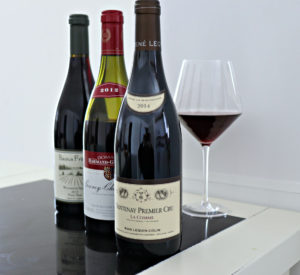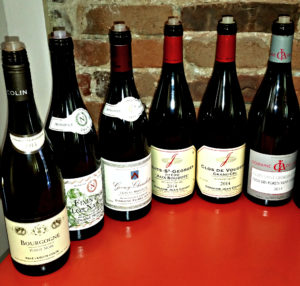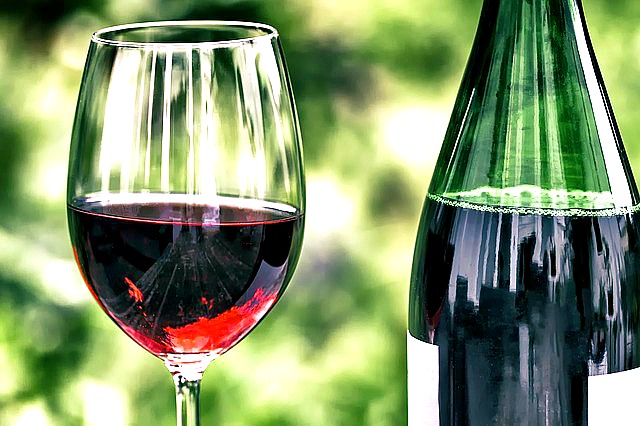Overview
Is it really that fair to compare and contrast Pinot Noir from France and Oregon? I think so. Having enjoyed the beauty of Burgundy and also being an Oregon Pinot Camp alumni, I feel that these two superior categories of Pinot Noir can be tasted side-by-side and still be appreciated for their differences in terroir. Current events have also put a spotlight on the Oregon/French connection. Regardless of political views, the recent White House State Dinner has brought significant attention to the wines of Oregon’s Willamette Valley and has popularized the interesting ties that these vines have to Burgundy (the motherland of Pinot Noir).

From right to left – Domaine René Lequin-Colin “La Comme” Santenay Premier Cru 2014, Domaine Harmand-Geoffroy Gevrey-Chambertin 2012, Beaux Freres Willamette Valley Pinot Noir 2015
It can be easy to over-generalize the two categories (admittedly I’m guilty of this on occasion) and say that Pinot Noir from France’s Burgundy region will be more earthy and acid-driven due to the climate and soil. One would then deduce that Pinot Noir from Oregon’s Willamette Valley would be more fruit forward and concentrated. While we can’t dismiss the fact that Willamette Valley has had some very warm years in recent vintages, we also must acknowledge the difficult growing conditions in Burgundy in recent vintages. These factors make it easier for outliers from each region to come to the forefront with their worldly flavor profiles which bring a more muted delineation of old world and new world variances.
Clones
Another component that joins these two regions is the expanded use of vine clones. Almost every notable Pinot Noir that I’ve tasted from Oregon uses at least one Burgundian clone in their vineyards. If you want to see me totally geek out, just mention Dijon clones 115, 667, and 777, or even Pommard clones. As I work on wrapping my head around what soils, climate, and conditions would best suit each, it can make for a very amusing snapshot. That’s why we have such fluency with Oregon producers like Domaine Drouhin and Domaine Serene. Not to mention that these producers have properties in Burgundy as well. You read that right, Domaine Drouhin actually has its roots in just about every region in Burgundy. While Domaine Serene also has property throughout Burgundy including a defined presence in Santenay.
Tasting
So, let’s get down to the nitty-gritty of tasting. For the Oregon wine, on my palate, Domaine Drouhin has always been an earthier depiction of Pinot Noir. This was especially apparent in later ripening vintages with lower alcohol content, specifically 2011. They just know exactly what they’re doing when it comes to expert winemaking. I’ve also been lucky enough to taste through several flights of Domaine Serene’s single vineyard selections including Fleur de Lis and Winery Hill, and I would have blind tasted the majority to be Burgundy. They were sturdy and refined with near-perfect levels of acidity and an abundance of red fruit. This Burgundian parallel also applied to Domaine Serene’s Chardonnay. The exquisite lees treatments and restrained oak regiment both played strong supporting roles, and as if on cue, they gracefully fell back to allow the wine to focus on the exceptional fruit that was born to be the star of the show. As a white wine lover, I couldn’t possibly have left this wine out (even though the post is technically about Pinot Noir, oops).
Albeit a bit more challenging mission is finding a Burgundy that has a fruitier component. The cooler and cloudier growing conditions makes this more of a task. I ask Burgundy to please bear with me and know that if it weren’t for some of these producers and vintages a segment of Americans wouldn’t have had their “aha” moment with Burgundy to get them interested in French wine. Deep breath, here it goes….Domaine Pierre Gelin, Fixin, 1er Cru, Clos Napoleon, 2014 had a dominant French oak influence that softened the bright cherry component and gave way to a darker fruit presence on the back of the palate. This softer and more delicate approach provides a familiar quality to people accustomed to Oregon Pinot Noir and makes the massive jump to France seem more like a small hurdle or a mere skip. Domaine Tollot-Beaut, Aloxe-Corton, 2014 also had the same affect with its subtly stewed dark red fruit notes that made it more round on the nose and the palate alike.

From left to right – Domaine René Lequin-Colin Bourgogne 2015, Pierre Gelin Fixin Premier Cru Clos Napoleon 2014, Pierre Gelin Gevrey Chambertin Clos de Meixvelle 2014, Jean Grivot Nuits St. Georges Premier Cru “Aux Boudots” 2014, Jean Grivot Clos de Vougeot Grand Cru 2014, Domaine de L’Arlot Nuits St. George Premier Cru, “Clos des Forets St. Georges” 2014.
In Conclusion
Has anyone else found themselves in the position of being surprised when a Pinot Noir blurred the lines of terroir? The best ones find a way to include encompassing aspects of several regions while still maintaining a strong sense of self. These “unicorns” not only evoke our attention, but they also bring excitement and a refreshingly new point of view to one of the most coveted and traditional wine varietals in the world. Does this mean I want Burgundy to stop tasting like Burgundy, or for Willamette Valley to lose its unique quality? Not a chance. I just personally enjoy it when something is still able to surprise me.




